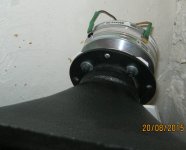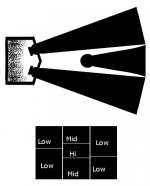2430 for $355.
Be aware that there is a 2430 compression driver, this is totally different to the D2430K used in the M2, despite the similar number.
The D2430K is about $1500 new so a $355 price is probably not for the correct driver.
Best wishes
David
Yes, 2430 is another, 3" $320 conventional driver.
Sorry 😱, 2430 was used as short colloquial number 🙂 for D2430K #5032754X.
"Product Description Brand New Genuine JBL D2430K Tweeter for JBL M2"
Sorry 😱, 2430 was used as short colloquial number 🙂 for D2430K #5032754X.
"Product Description Brand New Genuine JBL D2430K Tweeter for JBL M2"
Attachments
Last edited:
Has anyone ever dealt with speakerexchange ? Are they good and trustworthy ?
I am also interested in this HF driver. I don't intend to copy the M2 however. For that price that driver would be very interesting for a three-way system that is going as high as most domes and AMTs go (with proper EQing of course).
And I haven't found out what throat diameter it has so far. I guess it is 1.4" or 1.5".
Regards
Charles
I am also interested in this HF driver. I don't intend to copy the M2 however. For that price that driver would be very interesting for a three-way system that is going as high as most domes and AMTs go (with proper EQing of course).
And I haven't found out what throat diameter it has so far. I guess it is 1.4" or 1.5".
Regards
Charles
The JBL VTX F12...features the exact same compression driver as the M2...
This is not correct, the part numbers of the VTX transducers and the M2 are NOT the same.
I suspect the M2 drivers are just selected drivers, but perhaps assembled to closer tolerances.
There are no replacement parts for the M2 driver, need to replace the whole unit to maintain specification.
The VTX unit has replacement 'frams listed, which makes sense if the specifications are not so strict.
A moot point whether there's much real difference.
Has anyone ever dealt with speakerexchange ?...
I am also interested in this HF driver. I don't intend to copy the M2 however....
I had the same idea when the M2 was first shown and so I contacted them.
I have not yet purchased but their responses to enquiries was fast and helpful. I have not read any reports of problems, they seem to be the best source for these less common JBL components.
Some of the ex-VTX drivers from Ebay are a bit suspect apparently.
Best wishes
David
In the meantime I have found out that it is most probably a 1.5" driver which is a pity because it reduces the range of horns for mating significantly. Maybe it would be possible to chisel away a bit from a 1.4" horn but how it will behave is a little difficult to forecast.
But the problems would be most probably in the upper frequency range where the driver as such excels.
Regards
Charles
But the problems would be most probably in the upper frequency range where the driver as such excels.
Regards
Charles
I had. They are 🙂.Has anyone ever dealt with speakerexchange ? Are they good and trustworthy ?
There were problems with supply from the manufacturer..
I see no reason to worry if the product is in stock in speakerex. Fast shipping and good packing.
D2 is 1.5".
Magic Number
You need to produce unified coherent wave-front at the horn throat. To do this (7) drivers and a unifying phase plug are required as shown in the attached drawing. WHG
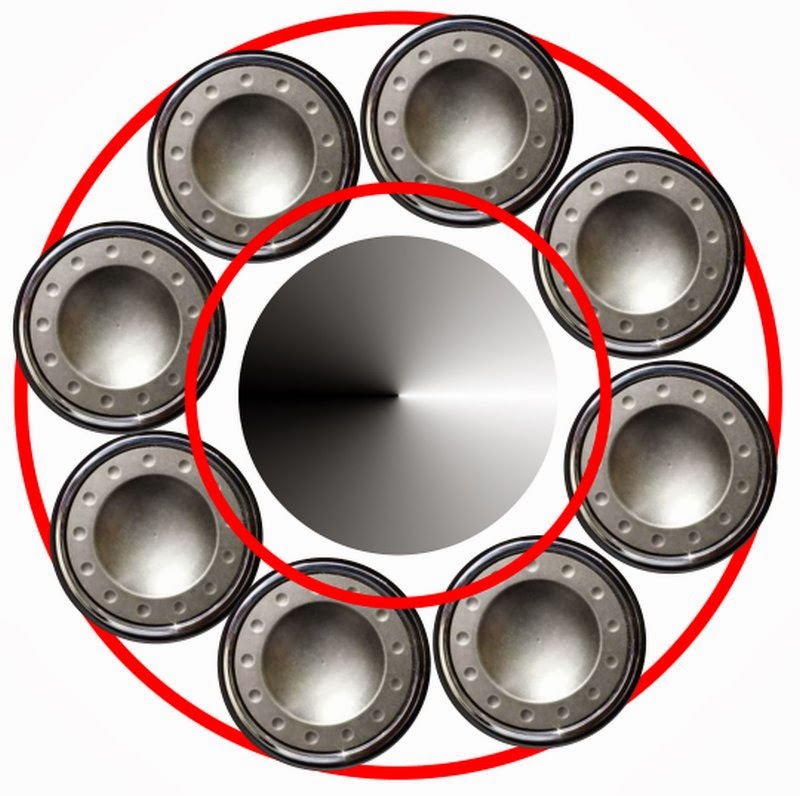
Here's a pic of what the ring shaped array would look like.
There are eight of the Parts Express tweeters in the array.
In this configuration, the ring is under five centimeters in diameter. (To be exact, it's 4.57cm in diameter.)
The sound radiates the exact same way as the BMS and the JBL, the only difference is that we're using $20 worth of computer speakers instead of $4000 worth of compression drivers.
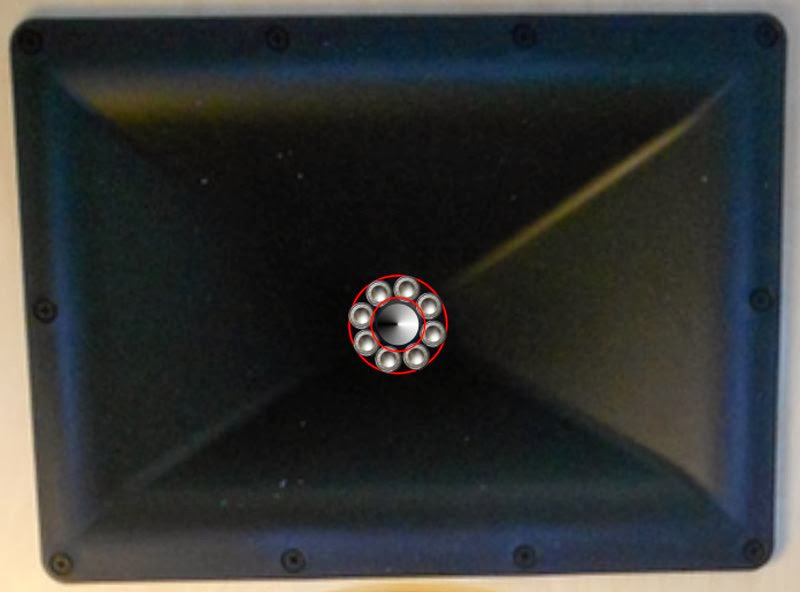
Here's a pic of what it would look like with a waveguide in front of it, in this case the QSC PL-000446GP. ($35 at PE.)
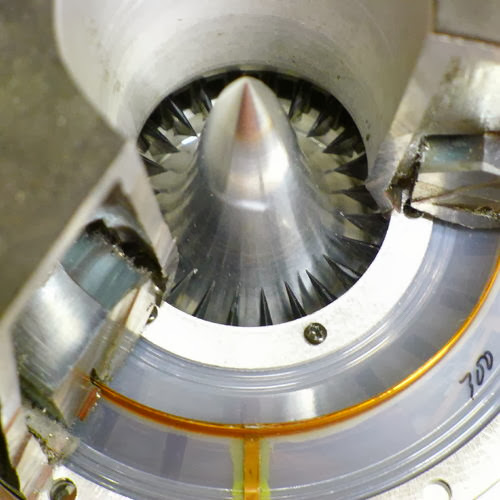
The array of 1/2" tweeters radiates into the horn exactly like this ^^^
QSC PL-000446GP Replacement Waveguide Horn for HPR152i | 245-625
1/2" Dome Tweeter Element 10 Pcs. | 275-010
Eight of the tweeters and one of the waveguides cost a whopping $60.
By comparison's sake, the D2430K doesn't have a listed price that I can find, though they can be found on eBay for about $450 used
The BMS 4550 is $150
You need to produce unified coherent wave-front at the horn throat. To do this (7) drivers and a unifying phase plug are required as shown in the attached drawing. WHG
Attachments
With six drivers in a ring, they're all equidistant from the throat
but if you added a seventh in the center, the pathlength would be unequal?
I do agree a phase plug is needed, and it would be fairly simple to copy Alexander Voshvillo's
but if you added a seventh in the center, the pathlength would be unequal?
I do agree a phase plug is needed, and it would be fairly simple to copy Alexander Voshvillo's
The inventor of this driver is giving a seminar on dual diaphragm compression drivers at the AES show this month.
With six drivers in a ring, they're all equidistant from the throat
but if you added a seventh in the center, the pathlength would be unequal?
I do agree a phase plug is needed, and it would be fairly simple to copy Alexander Voshvillo's
By design all the path lengths may be made equal including that of the center driver; however, it is not clear that this is a requirement for a coherence that delivers an optimal wave front shape. The issues that arise when combining the output of multiple drivers into a single horn throat do not have "simple" solutions. WHG
Last edited:
I have an alternative idea that I've been kicking around in my head a while. It is also quasi single point with multiple drivers. The engineering would be less fiddly than trying to get many drivers into a tiny throat, or trying to clone a Unity.
Simply do this: DIY a multicell, but use 1 driver per cell.
Middle cell: driven by a small compression driver selected for good HF performance.
Flanking cells: use conventional drivers, to cover 300-3kHz (ish).
The main criticisms of traditional multicells* seem to be comb filtering (lobing) and cost (difficulty) of construction.
My idea would reduce these problems: less lobing by only having one cell do HF. Construction could be much simpler** than a 'normal' multicell, as all the flanking horns could be very basic, conicals with rectangular cross section.
*Based on the writings / comments of others. I have not experienced a good multicell.
**I'd be tempted to make the actual construction as simple as possible, but layout more complex.
I've attached a roughly done but hopefully clear picture. Yes, it would need HF delay, if built as pictured. Mini DSP to the rescue 🙂
Simply do this: DIY a multicell, but use 1 driver per cell.
Middle cell: driven by a small compression driver selected for good HF performance.
Flanking cells: use conventional drivers, to cover 300-3kHz (ish).
The main criticisms of traditional multicells* seem to be comb filtering (lobing) and cost (difficulty) of construction.
My idea would reduce these problems: less lobing by only having one cell do HF. Construction could be much simpler** than a 'normal' multicell, as all the flanking horns could be very basic, conicals with rectangular cross section.
*Based on the writings / comments of others. I have not experienced a good multicell.
**I'd be tempted to make the actual construction as simple as possible, but layout more complex.
- use an off the shelf horn for the HF
- DIY conical horns for the rest
- use fewer horns, but more drivers (push-pull loading) for the lows
- vary the size / orientation of the flanking horn mouths, so their artifacts don't all pile up at the same frequency
I've attached a roughly done but hopefully clear picture. Yes, it would need HF delay, if built as pictured. Mini DSP to the rescue 🙂
Attachments
I would say thew main advantage of the driver everyone is intending to copy here is that it offers wide bandwidth and good power handling without having to resort to things like multiway arrangements and any sort of delay for proper integration etc.
If it can really be had for the price that is shown on Speaker Exchange then the only reaon to try to DIY something similar with a different topology is curiosity IMHO.
If it weren't for that seldom used throut exit size I would have ordered a pair for a three way right away.
Regards
Charles
If it can really be had for the price that is shown on Speaker Exchange then the only reaon to try to DIY something similar with a different topology is curiosity IMHO.
If it weren't for that seldom used throut exit size I would have ordered a pair for a three way right away.
Regards
Charles
Why not order the waveguide and mounting flange as well? Heck, they even sale the mounting flange, woofer and crossover(though it is meant to be active of course).? $1600+ a box and you got an M2...
The "crossover" is actually just a combination of DC protection and voltage divider for the tweeter. IIRC the original uses the same type of amp channel for tweeter and woofer. The difference is in the DSP setup of both channels. Therefore the voltage divider etc.
The original waveguide wouldn't look good on the type of speaker that I'd like to build (WMTW). But JBL seems to have quite a few other modern 1.5" waveguides that are not difficult to obtain. But yes, the original wavguide as such is not that expensive.
Regards
Charles
The original waveguide wouldn't look good on the type of speaker that I'd like to build (WMTW). But JBL seems to have quite a few other modern 1.5" waveguides that are not difficult to obtain. But yes, the original wavguide as such is not that expensive.
Regards
Charles
A few updates:
1) A couple of new relatives have popped up. The new studio speakers feature a compression driver with a 1/2" exit. The advantage of that size is that you can maintain constant directivity past 13500hz without resorting to a diffraction device like in the M2 and the SAW lens.
2) there's a dual diaphragm compression driver thats half the diameter of the D2430K. It is imaginatively named the D2415K
3) new D2430ks are now available for 70% of what they used to cost on eBay
1) A couple of new relatives have popped up. The new studio speakers feature a compression driver with a 1/2" exit. The advantage of that size is that you can maintain constant directivity past 13500hz without resorting to a diffraction device like in the M2 and the SAW lens.
2) there's a dual diaphragm compression driver thats half the diameter of the D2430K. It is imaginatively named the D2415K
3) new D2430ks are now available for 70% of what they used to cost on eBay
Why not order the waveguide and mounting flange as well? Heck, they even sale the mounting flange, woofer and crossover(though it is meant to be active of course).? $1600+ a box and you got an M2...
Finally not a so bad idea 🙂 ! One after has to concentrate on the mid-bass and bass, not vented for best results in home environment !
Too much simple for John ?😉.... But I like the idea of a good purchase instead being poor by buying too much drivers ! Total cost of ownership in diy ?
Last edited:
- Home
- Loudspeakers
- Multi-Way
- JBL M2 for The Poors
